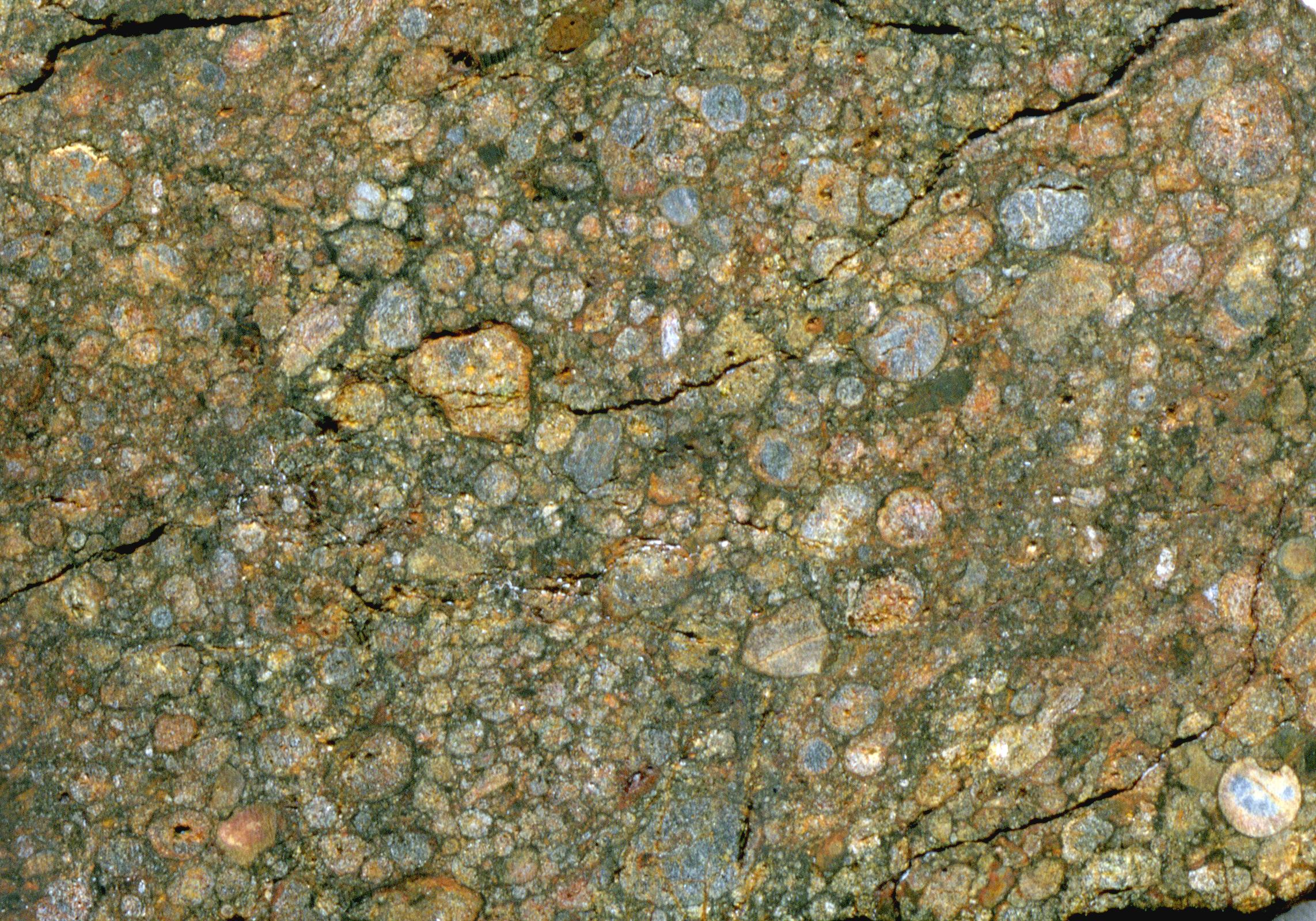|
Tamdakht Meteorite
The Tamdakht meteorite fell near Ouarzazate, Morocco on 20 December 2008 producing a strewn field of approximately by and two small impact craters, one of about diameter and depth at and the other of about diameter and depth at . The meteorite is named after a village close to the fall. On April 22, 2017 small bits of the meteorite were handed out to children at the Boston March for Science. Mineralogy Petrology: (by Albert Jambon, Omar Boudouma, D. Badia UPVI and M. Denise, MNHNP): Abundant chondrules with visible but not well-delimited outlines. Chondrule size is 0.1 to 1.5 mm. Dominant olivine and orthopyroxene. Abundant chromite, rare clinopyroxene and ilmenite. Numerous pockets with chromite, plagioclase and phosphate (merrilite and Cl-apatite). Kamacite, with deformed Neumann bands, and taenite, twinned troilite. Copper. Mode: metal+troilite 10%. Mineral compositions and geochemistry: log χ = 5.3. Olivine Fa18 ± 0.5 Opx = En83 Fs16 Wo2 Minor calcic pyroxe ... [...More Info...] [...Related Items...] OR: [Wikipedia] [Google] [Baidu] |
Ordinary Chondrite
The ordinary chondrites (sometimes called the O chondrites) are a class of stony chondritic meteorites. They are by far the most numerous group, comprising 87% of all finds. Hence, they have been dubbed "ordinary". The ordinary chondrites are thought to have originated from three parent asteroids, with the fragments making up the H chondrite, L chondrite and LL chondrite groups respectively. Origin It is suspected that they are not representative of typical asteroid parent bodies, but rather of a select few which are advantageously placed to send impact fragments to Earth-crossing orbits. Such positions are e.g. near Kirkwood gaps and/or secular resonances in the main asteroid belt. In fact, only the one rather insignificant asteroid 3628 Božněmcová has been identified to have a spectrum close to the ordinary chondrites. A probable parent body of the H chondrites (comprising about 46% of the ordinary chondrites) is 6 Hebe, but its spectrum is dissimilar due to what is likel ... [...More Info...] [...Related Items...] OR: [Wikipedia] [Google] [Baidu] |
Meteoritical Society
The Meteoritical Society is a non-profit scholarly organization founded in 1933 to promote research and education in planetary science with emphasis on studies of meteorites and other extraterrestrial materials that further our understanding of the origin and history of the Solar System. Members The membership of the society comprises over 1,000 scientists and amateur enthusiasts from over 52 countries who are interested in a wide range of planetary science topics. Members interests include meteorites, cosmic dust, asteroids and comets, natural satellites, planets, impact events, and the origins of the Solar System. Activities The Meteoritical Society is the organization that records all known meteorites in its '' Meteoritical Bulletin''. The Society also publishes one of the world's leading planetary science journals, ''Meteoritics & Planetary Science'', and is a cosponsor with the Geochemical Society of the renowned journal ''Geochimica et Cosmochimica Acta''. The Society presen ... [...More Info...] [...Related Items...] OR: [Wikipedia] [Google] [Baidu] |
Morocco
Morocco (),, ) officially the Kingdom of Morocco, is the westernmost country in the Maghreb region of North Africa. It overlooks the Mediterranean Sea to the north and the Atlantic Ocean to the west, and has land borders with Algeria to the east, and the disputed territory of Western Sahara to the south. Mauritania lies to the south of Western Sahara. Morocco also claims the Spanish exclaves of Ceuta, Melilla and Peñón de Vélez de la Gomera, and several small Spanish-controlled islands off its coast. It spans an area of or , with a population of roughly 37 million. Its official and predominant religion is Islam, and the official languages are Arabic and Berber; the Moroccan dialect of Arabic and French are also widely spoken. Moroccan identity and culture is a mix of Arab, Berber, and European cultures. Its capital is Rabat, while its largest city is Casablanca. In a region inhabited since the Paleolithic Era over 300,000 years ago, the first Moroccan s ... [...More Info...] [...Related Items...] OR: [Wikipedia] [Google] [Baidu] |
Ouarzazate
Ouarzazate (; ar, ورزازات, Warzāzāt, ; ary, وارزازات, Wārzāzāt; shi, label= Berber, ⵡⴰⵔⵣⴰⵣⴰⵜ, Warzazat), nicknamed ''the door of the desert'', is a city and capital of Ouarzazate Province in the region of Drâa-Tafilalet, south-central Morocco Morocco (),, ) officially the Kingdom of Morocco, is the westernmost country in the Maghreb region of North Africa. It overlooks the Mediterranean Sea to the north and the Atlantic Ocean to the west, and has land borders with Algeria to .... Ouarzazate is at an elevation of in the middle of a bare plateau south of the High Atlas Mountains, with a desert to the city's south. Berber-speakers make up the majority of the town's inhabitants, who were responsible for the creation of many of the prominent kasbahs (locally referred to as: ''iɣeṛman''). Ouarzazate is a primary tourist destination in Morocco during the holidays, as well as a starting point for excursions into and across the Draa ... [...More Info...] [...Related Items...] OR: [Wikipedia] [Google] [Baidu] |
Strewn Field
The term strewn field indicates the area where meteorites from a single fall are dispersed. It is also often used for the area containing tektites produced by large meteorite impact.''Tektites in the geological record: showers of glass from the sky''. Gerald Joseph Home McCall. Geological Society of London, 2001page 10/ref> Formation There are two strewnfield formation mechanisms: # Mid-air fragmentation: when a large meteoroid enters the atmosphere it often fragments into many pieces before touching the ground due to thermal shock. This mid-air explosion disperses material over a large oval-shaped area. The long axis of this oval is along the flight path of the meteoroid. When multiple-explosions occur, the material can be found in several overlapping ovals. # Impact fragmentation: when there is almost no mid-air fragmentation the fragmentation can occur upon impact. In this case the strewnfield shape can be different, usually circular. (e.g. Canyon Diablo at Meteor Crater; Austra ... [...More Info...] [...Related Items...] OR: [Wikipedia] [Google] [Baidu] |
March For Science
The March for Science (formerly known as the Scientists' March on Washington) is an international series of rallies and marches held on Earth Day. The inaugural march was held on April 22, 2017, in Washington, D.C., and more than 600 other cities across the world. According to organizers, the march is a non-partisan movement to celebrate science and the role it plays in everyday lives. The goals of the marches and rallies were to emphasize that science upholds the common good and to call for evidence-based policy in the public's best interest. The March for Science organizers, estimated global attendance at 1.07 million, with 100,000 participants estimated for the main March in Washington, D.C., 70,000 in Boston, 60,000 in Chicago, 50,000 in Los Angeles, 50,000 in San Francisco, 20,000 in Seattle, 14,000 in Phoenix, and 11,000 in Berlin. A second March for Science was held April 14, 2018. 230 satellite events around the world participated in the 2nd annual event, including Ne ... [...More Info...] [...Related Items...] OR: [Wikipedia] [Google] [Baidu] |
Cook Islands
) , image_map = Cook Islands on the globe (small islands magnified) (Polynesia centered).svg , capital = Avarua , coordinates = , largest_city = Avarua , official_languages = , languages_type = Spoken languages , languages = , ethnic_groups = , ethnic_groups_year = 2016 census , demonym = Cook Islander , government_type = , leader_title1 = Monarch , leader_name1 = , leader_title2 = 's Representative , leader_name2 = Sir Tom Marsters , leader_title3 = Prime Minister , leader_name3 = Mark Brown , leader_title4 = President of the House of Ariki , leader_name4 = Tou Travel Ariki , legislature = Parliament , sovereignty_type = Associated state of New Zealand , established_event1 = Self-governance , established_date1 = 4 August 1965 , establi ... [...More Info...] [...Related Items...] OR: [Wikipedia] [Google] [Baidu] |
Glossary Of Meteoritics
This is a glossary of terms used in meteoritics, the science of meteorites. # * 2 Pallas – an asteroid from the asteroid belt and one of the likely parent bodies of the CR meteorites. * 4 Vesta – second-largest asteroid in the asteroid belt and likely source of the HED meteorites. * 221 Eos – an asteroid from the asteroid belt and one of the likely parent bodies of the CO meteorites. * 289 Nenetta – an asteroid from the asteroid belt and one of the likely parent bodies of the angrites. * 3103 Eger – an asteroid from the asteroid belt and one of the likely parent bodies of the aubrites. * 3819 Robinson – an asteroid from the asteroid belt and one of the likely parent bodies of the angrites. * IA meteorite – an iron meteorite group now part of the IAB group/complex. * IAB meteorite – an iron meteorite and primitive achondrite of the IAB group/complex. * IB meteorite – an iron meteorite group now part of the IAB group/complex. * IC meteorite – an ... [...More Info...] [...Related Items...] OR: [Wikipedia] [Google] [Baidu] |
Meteorites Found In Morocco
A meteorite is a solid piece of debris from an object, such as a comet, asteroid, or meteoroid, that originates in outer space and survives its passage through the atmosphere to reach the surface of a planet or moon. When the original object enters the atmosphere, various factors such as friction, pressure, and chemical interactions with the atmospheric gases cause it to heat up and radiate energy. It then becomes a meteor and forms a fireball, also known as a shooting star; astronomers call the brightest examples " bolides". Once it settles on the larger body's surface, the meteor becomes a meteorite. Meteorites vary greatly in size. For geologists, a bolide is a meteorite large enough to create an impact crater. Meteorites that are recovered after being observed as they transit the atmosphere and impact the Earth are called meteorite falls. All others are known as meteorite finds. Meteorites have traditionally been divided into three broad categories: stony meteorites that a ... [...More Info...] [...Related Items...] OR: [Wikipedia] [Google] [Baidu] |





